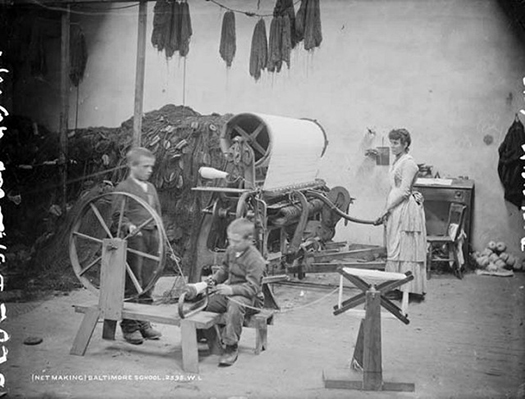
Another occupation connected with the fisheries was net-making. A number of different types of net were in use between 1700 and 1920 and these are described below.
Types of Net
Trammel Nets
In the 1940s, Mary O’Donovan of Rhearour, Kilcrohane, Bantry interviewed her relative Thomas O’Donovan for the Schools’ Folklore project. The information was recorded under her school: Ceann Caorach, Cill Crócháin, Caher, Co. Cork (roll number 15952). Thomas explained that in earlier times
hake-fishing was done with a large strong net called a “tramble”. They took it out in a boat & it was put in the water. At the top was a cork buoy and this remained on the surface so it was easy for the fisher-men to know the exact place where they put the net. After about an hour it was hauled up into the boat and the fish were taken out in the boat.
(The Schools’ Collection, Volume 0286, Page 023)
Bag Nets and Stake nets
‘In the 1820s ‘bag nets’ and ‘stake nets’ had been introduced for the capture of salmon. These instruments, legalised in 1842, superseded the traditional drift nets and brush head weirs. Sites for their erection were let by land-owners indiscriminately, the traditional fishermen were largely ruined and the former abundance of stock reduced, and never in fact restored’ (De Courcy Ireland, Ireland’s Sea Fisheries: A History, p.56).
Drift nets
Drift nets were used for catching herring and mackerel. Rynne notes that ‘Drift nets are suspended from floats and ‘drift’ below the surface to catch herring and mackerel; those used for mackerel, however, were made from a coarser and bigger mesh’ (citing McGaughan 1989, p.123). This was the principal type of fishing off the coast of Ireland. Rynne notes that ‘by the end of the nineteenth century, nets could be anything from a mile to one and a half miles long, and were, in this period, beginning to be hauled in by steam capstans’ (Rynne, p.201).
Seine nets
‘Seine netting involved two boats, which were used to skilfully manipulate a purse-like net around a shoal of fish. On the south coast, seine nets were up to 120 yards long and 30 ft deep, manufactured from small-mesh cotton, and once the fish were encircled, the net, which could weigh up to one ton when wet, could be closed shut by pulling a rope’ (Rynne, p.201 referencing N. Ó Clearigh 1992, Valentia a different Irish island (Dublin), pp.75-9).
Gill nets
Gill nets were mesh nets which could be drifted or anchored out at dusk. (Rynne, p.202 citing Green, 1902, pp.376-7).
Danish seine nets
These were ‘a cheap and effective means of catching white fish’. These started to be used in Irish waters at the turn of the twentieth century.
Trawler Gear
Rynne notes that ‘although drift netting was the principal means of catching fish off the coast of Ireland, trawling for bottom feeding fish had also been reasonably common from the eighteenth century onwards’. The main activity was, however, focused on the Irish Sea, so outside our study area (Rynne, p.203 citing Green 1902, pp.379-80 and de Courcy Ireland 1981, p.87).
The most common type of trawler gear in Ireland was the pole trawl. Rynne notes that this ‘consisted of a bay and wings, distended by poles projecting from either side of a traditional fishing vessel, such as a hooker’. (Rynne, p.203 citing Green 1902, pp.379-80 and de Courcy Ireland 1981, p.87).
Otter boards were introduced after 1860 and ‘enabled a much wider spread to the net’ (Rynne, p.203 citing Green 1902, pp.379-80 and de Courcy Ireland 1981, p.87).
Lines
Lines were also used. This description describes the ‘spiller’ – a line which was used by fishermen in the area around Glandore.
Sometimes the fishermen use a form of fishing line or lines known as a “spiller”. It consists of one long line with several small pieces of line attached to it at fixed distances and on each there is a hook and bait. This is set in such a way that it stretches along the sea-floor and it is moored at each end and also buoyed. The form of buoy used is the tarred skin of a dog or other small animal. This line is not reeled up but is coiled on a flat tray-like wicker-work. When hung up to dry it is suspended by the hooks from a piece of stick. This enables it to be dried without becoming tangled.
(The Schools’ Collection, Volume 0309, Page 299)
>> Fishermen

